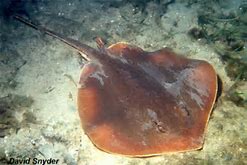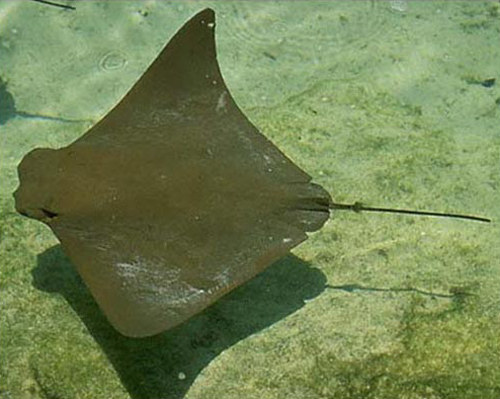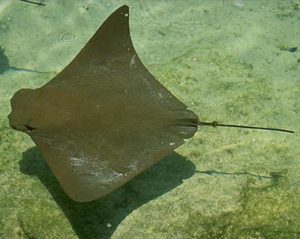
by Rick O'Connor | Aug 10, 2024
I was recently conducting a survey for diamondback terrapins from my paddleboard in a small estuarine lagoon within the Pensacola Bay System. Even if we do not find our target species during these surveys – I, and our volunteers, see all sorts of other cool wildlife. On this trip I was treated to nesting osprey, a kingfisher, large blue crabs, and even a swimming eel. But one neat encounter was the numerous stingrays.

The Atlantic Stingray is one of the common members of the ray group who does possess a venomous spine.
Photo: Florida Museum of Natural History
They were lying in the sand and grassbeds, lots of them, and they all seemed to be of one species – the Atlantic stingray. My brain immediately went to “breeding season”, but when I checked the literature, I found that it was not breeding season, but pupping season – the babies were being born.
Atlantic Stingray (Dasyatis sabina) are true stingrays in the family Dasyatidae. This means they do possess the replaceable serrated venomous barb that makes these animals so famous. They are one of the smaller members of this family. Females can reach a disk width of two feet while the smaller males will only reach about one foot. Atlantic stingrays are a warm water species, migrating if they need to find suitable temperatures. They have been found in water as deep as 80 feet but are more common in the warmer shallower waters near shore. They are very common in our estuaries and being euryhaline (they tolerate a large range of salinity), are found in freshwater systems. There is a population that lives in the St. Johns River. Atlantic stingrays feed on a variety of benthic invertebrates and have special cells in the nose to detect the weak electric fields their prey give off while buried in the sediment. They also like to bury in the sand to ambush prey as they move by.
Breeding occurs in the fall. The smaller males possess two modified fins called claspers connected to their anal fins that are used to transfer sperm to the female. The males have modified teeth they can use to bite the fins of the females. They do this to hold on and make sperm transfer more successful.
The females do not begin to ovulate until spring. So, though they receive the sperm in the fall, fertilization does not occur until the spring. Instead of laying eggs, as some rays and skates do, baby Atlantic stingrays develop within the mother. This is not the same as mammals, who produce a placental to feed the developing young, but more like an internal egg with no hard shell. The embryo is attached to, and feeds from, a yolk sac. Gestation takes about 60 days at which time the yolk sac is depleted, and the young must emerge. Birth usually occurs in late July and early August, and each female will produce 1-4 small pups whose disk are about 10cm (4in.) wide. It was this birthing/pupping period I witnessed.
I returned the following day to search for terrapins and the number of stingrays was significantly fewer. It may be that the birthing process is fast, and the adults leave the coves afterwards. It may have been because that day was the day Hurricane Debby was making landfall east of us and the water levels were abnormally high – something the rays may have noticed and decided to leave – I am not sure.
I was really hoping to see the young rays swimming around – I did not – but plan to search again soon. Stingrays make many people nervous. I witnessed several adult rays whose tails had been cut off – which is very unfortunate – but they are actually cool creatures and fun to watch while paddleboarding. Maybe I will see a baby soon.
References
Dasyatis sabina. 2023. Florida Museum of Natural History. https://www.floridamuseum.ufl.edu/discover-fish/species-profiles/dasyatis-sabina/.
Johnson, M.R., Snelson Jr., F.F. 1996. Reproductive Life History of the Atlantic Stingray, Dasyatis sabina (Pisces, Dasyatidae), in Freshwater St. Johns River, Florida. Bulletin of Marine Science, 59(1): 74-88.

by Rick O'Connor | Jun 18, 2021
In our continuing series on the biogeographic distribution of island vertebrates, this week we look at a creature that, for some, is as scary as sharks – the rays. The term stingray conjures up stinging barbs and painful encounters, and these have happened, but rays are easily scared away by our activity. Occasionally people will step on one and the venomous spine is used to make you move your foot. You can avoid this by shuffling your feet when moving across the sand. Rays detect the pressure and move before you reach them. Again, negative encounters with rays are not common.

The Atlantic Stingray is one of the common members of the ray group who does possess a venomous spine.
Photo: Florida Museum of Natural History
There are 18 species of rays (from 9 families) found in our area. An interesting note, only eight of those possess a barb for stinging, and five are from the family Dasyatidae (the stingrays). Others that have barbs include the butterfly ray, cownose ray, and the eagle ray.
Rays are related to sharks but differ in that (a) the pectoral fin begins before the gills slits, and (b) the gill slits are on the underneath of the body – not on the side as found in sharks. Shark distribution seems to be controlled by water temperature. We see this with ray distribution as well, but interestingly the skates seem to be restricted to the Gulf of Mexico. Some are found almost exclusively in the east or west side of the Gulf.
Skates resemble stingrays but lack the venomous barb. They will usually have small thorns on their bodies and lay their developing embryos in a leathery egg case folks call “mermaid’s purse” when they wash ashore. There are four species found in the Gulf, but the spreadfin skate is ONLY found in the Gulf of Mexico and is not found along the Florida peninsula. The clearnose skate, which can be found all along Florida and the eastern seaboard of the U.S., is absent from western Gulf. It is interesting to try and understand why. What barrier keeps these two skates from colonizing the entire Gulf?
There is a large plume of muddy freshwater that expands from the Mississippi River into the Gulf off Louisiana. This plume could be a barrier for coastal species trying to expand their range. However, the spreadfin skate is reported to be an outer continental shelf species and may not be influenced by this lower salinity water. So, what is their story?
And why are these not found in the Caribbean? In the Caribbean you do enter tropical waters where coral reefs become more common. There is certainly a species shift when you reach this zone and it could be the food needed by these skates is not found here – a biological barrier. Many find these biogeographic situations interesting.
There are 12 species that have the typical “Carolina marine fish” distribution, which means they are found throughout the Gulf up the eastern seaboard to Massachusetts and south to Brazil. Two, the Atlantic torpedo ray and the roughtail stingray, expand their range farther into Canada. As a matter of fact, the roughtail stingray prefers colder waters.
Torpedo rays are an interesting group. This family of fish includes two species here in the Gulf, the Atlantic torpedo ray and the lesser electric ray. Yep… these two have special muscle cells that can deliver an electric shock. It is believed this electric current can detect and stun prey as well as repel predators. The voltage is not dangerous but will get your attention.
Three of those “Carolina marine species,” the guitarfish, the lesser electric ray, and the yellow stingray, do not reach Massachusetts. Their distribution ends at North Carolina. You would have to guess water temperature as a barrier here. The warm Gulf stream begins heading east across the Atlantic Ocean off Cape Hatteras towards Europe. They could follow this current to Bermuda, but they have not been reported there. This could be due to depth (pressure), being benthic fish, or food barriers.
There is one family that is tropical, the sawfish. These bizarre dinosaur looking creatures were once common in the estuaries of the Gulf region. They are now rare and protected.
One species of stingray, the Atlantic stingray has been found in the lower reaches of Louisiana rivers. Like bull sharks, salinity may not be a barrier for them.
And then we have our “world travelers”. The manta and eagle rays are found across the globe in tropical waters, and eagle rays are common in temperate parts of the world.
The distribution of our rays is not as universal as sharks. The skates in particular have an interesting distribution pattern. Pensacola lies right at the boundary of the eastern and western Gulf of Mexico, so we find both geographic groups here. Though they may scare many people, rays are fascinating creatures and cool to see.

by Rick O'Connor | May 31, 2018
It is now late May and in recent weeks I, and several volunteers, have been surveying the area for terrapins, horseshoe crabs, and monitoring local seagrass beds. We see many creatures when we are out and about; one that has been quite common all over the bay has been the “stingray”.

The cownose ray is often mistaken for the manta ray. It lacks the palps (“horns”) found on the manta.
Photo: Florida Sea Grant
These are intimidating creatures… everyone knows how they can inflict a painful wound using the spine in their tail, but may are not aware that not all “stingrays” can actually use a spine to drive you off – actually, not all “rays” are “stingrays”.
So what is a ray?
First, they are fish – but differ from most fish in that they lack a bony skeleton. Rather it is cartilaginous, which makes them close cousins of the sharks.
So what is the difference between a shark and a ray?
You would immediately jump on the fact that rays are flat disked-shape fish, and that sharks are more tube-shaped and fish like. This is probably true in most cases, but not all. The characteristics that separate the two groups are
- The five gill slits of a shark are on the side of the head – they are on the ventral side (underside) of a ray
- The pectoral fin begins behind the gill slits in sharks, in front of for the ray group
Not all rays have the whip-like tail that possess a sharp spine; some in fact have a tube-shaped body with a well-developed caudal fin for a tail.
There are eight families and 19 species of rays found in the Gulf of Mexico. Some are not common, but others are very much so.
Sawfish are large tube-shaped rays with a well-developed caudal fin. They are easily recognized by their large rostrum possessing “teeth” giving them their common name. Walking the halls of Sacred Heart Hospital in Pensacola, you will see photos of fishermen posing next to monsters they have captured. Sawfish can reach lengths of 18 feet… truly intimidating. However, they are very slow and lethargic fish. They spend their lives in estuaries, rarely going deeper than 30 feet. They were easy targets for fishermen who displayed them as if they caught a true monster. Today they are difficult to find and are protected. There are still sightings in southwest Florida, and reports from our area, but I have never seen one here. I sure hope to one day. There are two species in the Gulf of Mexico.
Guitarfish are tube-shaped rays that are very elongated. They appear to be sharks, albeit their heads are pretty flat. They more common in the Gulf than the bay and, at times, will congregate near our reefs and fishing piers to breed. They are often confused with the electric rays called torpedo rays, but guitarfish lack the organs needed to deliver an electric shock. They have rounded teeth and prefer crustaceans and mollusk to fish. There is only one species in the Gulf.
Torpedo rays can deliver an electric shock – about 35 volts of one. Though there are stories of these shocking folks to death, I am not aware of any fatalities. Nonetheless, the shock can be serious and beach goers are warned to be cautious. I once mistook one buried in the sand for a shell. Let us just say the jolt got my attention and I may have had a few words for this fish before I returned to the beach. We have two species of torpedo rays in the Gulf of Mexico.
Skates look JUST like stingrays – but they lack the whip-like tail and the venomous spine that goes with it. They are very common in the inshore waters of the Florida Panhandle and though they lack the terrifying spine we are all concerned about, they do possess a series of small thorn-like spine on the back that can be painful to the bare foot of a swimmer. Skates are famous for producing the black egg case folks call the “mermaids’ purse”. These are often found dried up along the shore of both the Gulf and they bay and popular items to take home after a fun day at the beach. There are four species of skates found in the Gulf of Mexico.
Stingrays… this is the one… this is the one we are concerned about. Stingrays can be found on both sides of our barrier islands and like to hide beneath the sand to ambush their prey. More often than not, when we approach they detect this and leave. However, sometimes they will remain in the sand hoping not to be detected. The swimmer then steps on their backs forcing them to whip their long tail over and drive the serrated spine into your foot. This usually makes you move off them – among other things. The piercing is painful and spine (which is actually a modified tooth) possesses glands that contain a toxic substance. It really is no fun to be stung by these guys. Many people will do what is called the “stingray shuffle” as they move through the water. This is basically sliding your feet across the sand reducing your chance of stepping on one. They are no stranger to folks who visit St. Joe Bay. The spines being modified teeth can be easily replaced after lodging in your foot. Actually, it is not uncommon to find one with two or three spines in their tails ready to go. Stingrays do not produce “mermaids’ purses” but rather give live birth. There are five species in the Gulf of Mexico.

The Atlantic Stingray is one of the common members of the ray group who does possess a venomous spine.
Photo: Florida Museum of Natural History
Butterfly ray is a strange looking fish and easy to recognize. The wide pectoral fins and small tail gives it the appearance of a butterfly. Despite the small tail, it does possess a spine. However, the small tail makes it difficult for the butterfly ray to pierce you with it. There is only one species in the Gulf, the smooth butterfly ray.
Eagle rays are one of the few groups of rays that actually in the middle of the water column instead of sitting on the ocean floor. They can get quite large and often mistaken for manta rays. Eagle rays lack the palps (“horns”) that the manta ray possesses. Rather they have a blunt shaped head and feed on mollusk. They do have venomous spines but, as with the butterfly ray, their tails are too short to extend and use it the way stingrays do. There are two species. The eagle ray is brown and has spots all over its back. The cownose ray is very common and almost every time I see one, I hear “there go manta rays”… again, they are not mantas. They have a habit of swimming in the surf and literally body surfing. Surfers, beachcombers, and fishermen frequently see them.
Last but not least is the very large Manta ray. This large beast can reach 22 feet from wingtip to wing tip. Like eagle rays, they swim through the ocean rather than sit on the bottom. They have to large “horns” (called palps) that help funnel plankton into their mouths. These horns give them one of their common names – the devilfish. Mantas, like eagle and butterfly rays, do have whip-like tails and a venomous spine, but like the above, their tails are much shorter and so effective placement of the spine in your foot is difficult.
Many are concerned when they see rays – thinking that all can inflict a painful spine into your foot – but they are actually really neat animals, and many are very excited to see them.
References
Hoese, H.D., R.H. Moore. 1977. Fishes of the Gulf of Mexico; Texas, Louisiana, and Adjacent Waters. Texas A&M. College Station, TX. pp. 327.
Shipp, R. L. 2012. Guide to Fishes of the Gulf of Mexico. KME Seabooks. Mobile AL. pp. 250.




